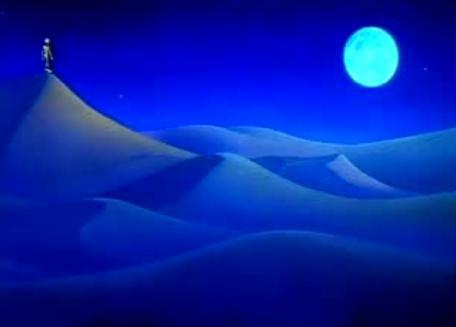American expatriate writer and composer Paul Bowles (1910-1999) once wrote a little travel essay titled “Baptism of Solitude.” The essay describes what he tells us the French call le bapteme de la solitude, referring to the unique sensation of encountering the desert, specifically the Sahara Desert, whether for the “first or the tenth time.” The essay opens:
Immediately when you arrive in the Sahara, for the first or the tenth time, you notice the stillness. An incredible, absolute silence prevails outside the towns, and within, even in busy places like the markets, there is a hushed quality in the air, as if the quiet were a conscious force which, resembling the intrusion of sound, minimizes and disperses sound straightaway.
The absence of sound, which is silence, is only part of a natural component of solitude.
Then there is the sky, compared to which all other skies seem faint-hearted efforts. Solid and luminous, it is always the focal point of the landscape.
Bowles describes the sky at night, which though filled with stars is never quite dark but “an intense and burning blue.” And there is nothing else, especially leaving the town, the camels, and going up into the dunes, or out on a stone ledge, leaving everything behind. The peculiar sensation — if the viewer does not rush back inside — is a desire to linger, to stay.
It is a unique sensation, and it has nothing to do with loneliness, for loneliness presupposes memory. Here, in this wholly mineral landscape lighted by stars like flares, even memory disappears; nothing is left but your own breathing and the sound of your heart beating. A strange, and by no means pleasant, process of reintegration begins inside you, and you have the choice of fighting against it, and insisting on remaining the person you have always been, or letting it take its course. For no one who has stayed in the Sahara for a while is quite the same as when he came.
The rest of the essay goes on to describe the social life of Arabs, Touaregs, Sudanese and Mauritanian blacks, and the French in the Sahara before Algeria independence. Bowles describes the wonderful oases and their verdant orchards and grainfields, the extremes of day and night temperatures, the rare but turbulent rainfalls, the effect of the desert on the White Fathers — the religious order of missionaries who ended up acquiring “a certain healthy and unorthodox fatalism.” The essay is a consummate piece of travel literature.
“Baptism of Solitude” does not pursue the historical meaning of the desert. It is an introduction for moderns and Westerners, but anyone acquainted with the early Christian desert hermits will fill in the psychological side that Bowles’ descriptive and suggestive essay begins to describe. He comes to the edge of this vast topic of desert solitude, of the absoluteness it represents, aware that his reader can only come so far with him. So Bowles concludes about what going to the desert ought to suggest to a modern-minded person.
Perhaps the logical question to ask at this point is: Why go? The answer is that when a man has been there and undergone the baptism of solitude he can’t help himself. Once he has been under the spell of the vast, luminous, silent country, no other place is quite strong enough for him, no other surroundings can provide the supremely satisfying sensation of existing in the midst of something that is absolute. He will go back, whatever the cost in comfort and money, for the absolute has no price.
Bowles recorded a reading of this essay in 1994 at his home in Tangiers. The sense of Bowles’ essay and spoken words are imaginatively captured by a 2000 short graphic film “Baptism Of Solitude: A Tribute To Paul Bowles” by Tonya Hurley, available on YouTube.

